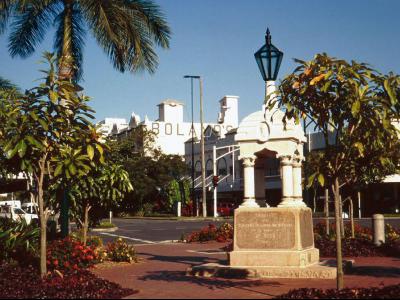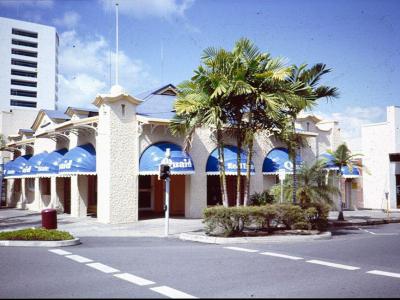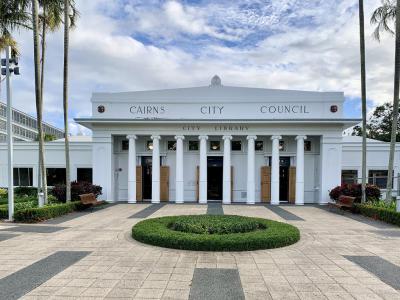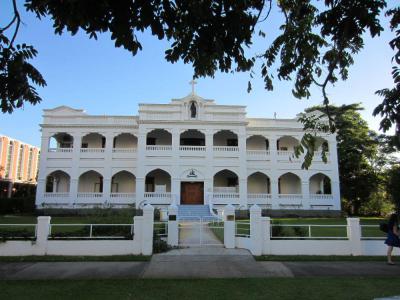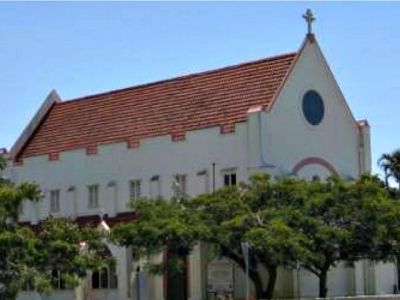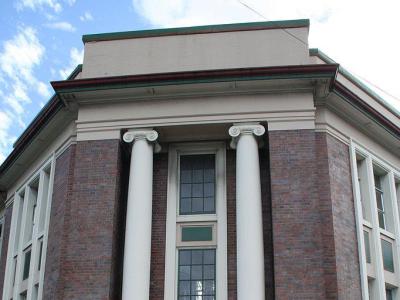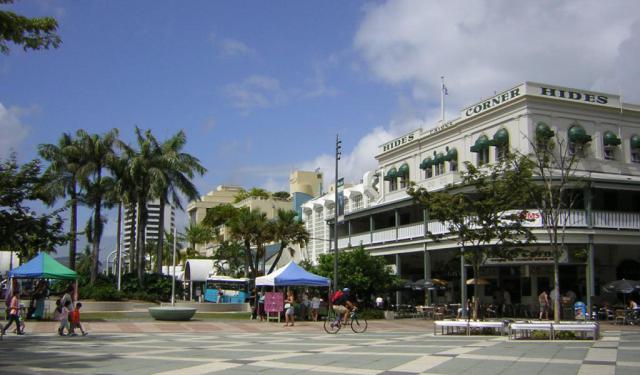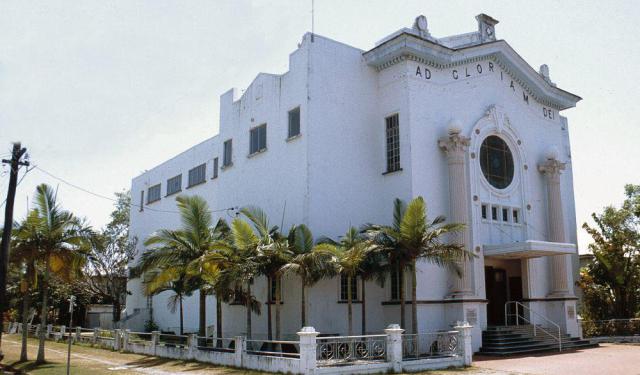
Cairns' Historical Buildings Walking Tour (Self Guided), Cairns
The vibrant port town of Cairns, ensconced on the verdant fringes of Australia's sun-kissed northeastern coast, stands as a live manifestation of its storied past, adorned with a collection of historical edifices that exude an air of refined antiquity and cultural grandeur. Each architectural gem, a chapter in the city's chronicle, beckons admirers to embark upon a journey through time.
One such is the emblematic Barrier Reef Hotel, a prominent landmark that has graced Cairns' skyline since 1926. Its architectural elegance epitomized the convergence of leisure and sophistication, serving as an illustrious locus where society's luminaries gathered in harmonious revelry.
Amid the historical landscape of Cairns, the Adelaide Steamship Co Ltd Building presents itself as a relic of the city's maritime ascendancy. Its visage bespeaks seafaring connections and trading prowess, encapsulating an era when the maritime realm burgeoned with tales of exploration and trade.
The Cairns Court House Complex, a dignified edifice resonating with legal gravity, stands as a beacon of justice within the city's narrative.
Another noteworthy sight in the urban tapestry is the Cairns City Council Chambers and City Library, emerging as architectural paragons, repositories of knowledge and governance.
Meanwhile, the Cairns Masonic Temple, an enigmatic enclave of fraternal camaraderie, emanates an aura of mystique within the urban panorama. Its architecture serves as a focal point for a community bound by shared values and enigmatic rituals, enshrouding the building in an air of timeless intrigue.
Collectively, these and other historical treasures weave a tableau of Cairns' yesteryears, showcasing its development, cultural diversity, religious heritage, and architectural evolution. If you're a history or architecture buff with an ear for the echoes of bygone eras resonating within the buildings' walls, this self-guided walk may be a good opportunity for you to indulge your passion.
One such is the emblematic Barrier Reef Hotel, a prominent landmark that has graced Cairns' skyline since 1926. Its architectural elegance epitomized the convergence of leisure and sophistication, serving as an illustrious locus where society's luminaries gathered in harmonious revelry.
Amid the historical landscape of Cairns, the Adelaide Steamship Co Ltd Building presents itself as a relic of the city's maritime ascendancy. Its visage bespeaks seafaring connections and trading prowess, encapsulating an era when the maritime realm burgeoned with tales of exploration and trade.
The Cairns Court House Complex, a dignified edifice resonating with legal gravity, stands as a beacon of justice within the city's narrative.
Another noteworthy sight in the urban tapestry is the Cairns City Council Chambers and City Library, emerging as architectural paragons, repositories of knowledge and governance.
Meanwhile, the Cairns Masonic Temple, an enigmatic enclave of fraternal camaraderie, emanates an aura of mystique within the urban panorama. Its architecture serves as a focal point for a community bound by shared values and enigmatic rituals, enshrouding the building in an air of timeless intrigue.
Collectively, these and other historical treasures weave a tableau of Cairns' yesteryears, showcasing its development, cultural diversity, religious heritage, and architectural evolution. If you're a history or architecture buff with an ear for the echoes of bygone eras resonating within the buildings' walls, this self-guided walk may be a good opportunity for you to indulge your passion.
How it works: Download the app "GPSmyCity: Walks in 1K+ Cities" from Apple App Store or Google Play Store to your mobile phone or tablet. The app turns your mobile device into a personal tour guide and its built-in GPS navigation functions guide you from one tour stop to next. The app works offline, so no data plan is needed when traveling abroad.
Cairns' Historical Buildings Walking Tour Map
Guide Name: Cairns' Historical Buildings Walking Tour
Guide Location: Australia » Cairns (See other walking tours in Cairns)
Guide Type: Self-guided Walking Tour (Sightseeing)
# of Attractions: 12
Tour Duration: 2 Hour(s)
Travel Distance: 2.4 Km or 1.5 Miles
Author: HelenF
Sight(s) Featured in This Guide:
Guide Location: Australia » Cairns (See other walking tours in Cairns)
Guide Type: Self-guided Walking Tour (Sightseeing)
# of Attractions: 12
Tour Duration: 2 Hour(s)
Travel Distance: 2.4 Km or 1.5 Miles
Author: HelenF
Sight(s) Featured in This Guide:
- Barrier Reef Hotel
- Dr EA Koch Memorial
- Adelaide Steamship Company Ltd Building
- Hides Hotel
- Cairns Court House Complex
- Cairns City Council and City Library
- Saint Joseph's Convent
- Saint Monica's Cathedral
- Bishop's House
- Saint John The Evangelist Anglican Church
- Cairns Masonic Temple
- Cairns State High School
1) Barrier Reef Hotel
The Barrier Reef Hotel, formerly known as the Empire Hotel, is a historic and heritage-listed establishment. Designed by Lawrence and Lordan in conjunction with Richard Hill, and constructed in 1926 by Carl Peter Jorgensen, the hotel stands as a testament to the region's rich architectural history.
Originally commissioned by PJ Doyle Ltd, wine and spirit merchants of Cairns and Thursday Island, the Barrier Reef Hotel was intended to replace the earlier Empire Hotel that had been operating on the same site since 1898. The hotel was strategically positioned at the corner of Wharf and Abbott Streets, offering visitors and guests a prominent and easily accessible location.
The building itself is a two-storeyed structure made of reinforced concrete, showcasing the architectural styles prevalent during the 1920s. One of its distinctive features is the wide verandah attached to the parapet walls along Wharf and Abbott Streets. Supported by sturdy timber posts, the verandah boasts an evenly spaced design, with the posts on either side of the street intersection deliberately absent—a unique and original touch that adds character to the building.
The verandah exhibits a simple slatted balustrade at the first-floor level, while a later skirt with a segmental profile of slatted boards sits below it between the supporting posts. Although the verandah on Abbott Street has been enclosed at the first-floor level, the building still retains its charm and historical significance.
Originally commissioned by PJ Doyle Ltd, wine and spirit merchants of Cairns and Thursday Island, the Barrier Reef Hotel was intended to replace the earlier Empire Hotel that had been operating on the same site since 1898. The hotel was strategically positioned at the corner of Wharf and Abbott Streets, offering visitors and guests a prominent and easily accessible location.
The building itself is a two-storeyed structure made of reinforced concrete, showcasing the architectural styles prevalent during the 1920s. One of its distinctive features is the wide verandah attached to the parapet walls along Wharf and Abbott Streets. Supported by sturdy timber posts, the verandah boasts an evenly spaced design, with the posts on either side of the street intersection deliberately absent—a unique and original touch that adds character to the building.
The verandah exhibits a simple slatted balustrade at the first-floor level, while a later skirt with a segmental profile of slatted boards sits below it between the supporting posts. Although the verandah on Abbott Street has been enclosed at the first-floor level, the building still retains its charm and historical significance.
2) Dr EA Koch Memorial
The Dr EA Koch Memorial is a historic and revered heritage-listed memorial. Designed by Melrose & Fenwick and constructed in 1903, it stands as a testament to the significant contributions of Dr Edward Albert Koch to the field of tropical medicine in the late 19th century. The memorial was added to the Queensland Heritage Register on 27 May 1997, recognizing its historical and cultural importance.
Dr Edward Albert Koch was a prominent figure in the Cairns community, serving as the head of Cairns hospital and running his own medical practice in the town. His exceptional medical skills, compassionate nature, and dedication to humanitarian work earned him the respect and admiration of the local residents. Particularly noteworthy was his expertise in treating tropical fevers, most notably malaria, which was a prevalent and deadly disease in far north Queensland during that time. In the 1880s, Dr Koch was one of the early pioneers in understanding the role of mosquitoes as carriers of the malaria parasite.
The Dr EA Koch Memorial, situated in Anzac Memorial Park. The design of the memorial is a testament to its historical significance. It consists of a square, rough-finished granite plinth supporting a polished granite base, standing at approximately 1 meter (3 feet 3 inches) in height. On this base, four finely crafted marble columns rise to support an elegant dome structure.
Within the dome, on two sides, are beautifully sculpted likenesses of Dr Koch, carved from Carrara marble. These artistic representations serve to immortalize the memory of the esteemed doctor and his contributions to the community. The inscription on two faces of the polished granite base reads: "Erected by citizens of Cairns and District to the memory of Dr Koch 1901," paying homage to the public's gratitude and appreciation for his life's work.
Over time, the memorial has undergone some changes to maintain its integrity and functionality. Above the dome, a recent lamp fitting and lamp have been added, replicating the original lighting element that may have adorned the memorial in the past.
Dr Edward Albert Koch was a prominent figure in the Cairns community, serving as the head of Cairns hospital and running his own medical practice in the town. His exceptional medical skills, compassionate nature, and dedication to humanitarian work earned him the respect and admiration of the local residents. Particularly noteworthy was his expertise in treating tropical fevers, most notably malaria, which was a prevalent and deadly disease in far north Queensland during that time. In the 1880s, Dr Koch was one of the early pioneers in understanding the role of mosquitoes as carriers of the malaria parasite.
The Dr EA Koch Memorial, situated in Anzac Memorial Park. The design of the memorial is a testament to its historical significance. It consists of a square, rough-finished granite plinth supporting a polished granite base, standing at approximately 1 meter (3 feet 3 inches) in height. On this base, four finely crafted marble columns rise to support an elegant dome structure.
Within the dome, on two sides, are beautifully sculpted likenesses of Dr Koch, carved from Carrara marble. These artistic representations serve to immortalize the memory of the esteemed doctor and his contributions to the community. The inscription on two faces of the polished granite base reads: "Erected by citizens of Cairns and District to the memory of Dr Koch 1901," paying homage to the public's gratitude and appreciation for his life's work.
Over time, the memorial has undergone some changes to maintain its integrity and functionality. Above the dome, a recent lamp fitting and lamp have been added, replicating the original lighting element that may have adorned the memorial in the past.
3) Adelaide Steamship Company Ltd Building
The Adelaide Steamship Company Ltd Building is a cherished heritage-listed office building. Constructed in 1910 by Wilson & Baillie, the building holds historical and architectural significance, reflected by its inclusion in the Queensland Heritage Register on 9th July 1993.
This single-storeyed structure boasts a rough-rendered masonry facade, located at the corner of Lake and Spence Street on the southwestern edge of Cairns' central business district. Its design and detailing showcase a strong influence of the Arts and Crafts architectural style, giving it a distinctive and captivating appearance.
The Adelaide Steamship Company Ltd Building features a corrugated iron roof with shaped end gables and sprocketted eaves, creating an attractive and unique roofline. Curved metal brackets support the eaves, which are pierced by tapering piers featuring shallow ogee-shaped gablets above. The corner and end piers are topped with spheres, adding a touch of elegance to the building's exterior. The building's charm is further enhanced by arcaded verandahs along both street frontages.
The Lake Street facade boasts a shallow ogee-shaped central gable that once housed the entry but now features a recessed window. Above the window, in relief, are the words "THE ADELAIDE STEAMSHIP COMPANY LTD," paying homage to the original purpose of the building. A sculpture of one of their vessels adds a decorative touch, commemorating the maritime heritage associated with the Adelaide Steamship Company. The Spence Street facade culminates with a wall return featuring a keyhole-shaped gateway adorned with scroll details above.
Inside, the building has undergone refurbishments to adapt to modern requirements, while still preserving its historical character.
This single-storeyed structure boasts a rough-rendered masonry facade, located at the corner of Lake and Spence Street on the southwestern edge of Cairns' central business district. Its design and detailing showcase a strong influence of the Arts and Crafts architectural style, giving it a distinctive and captivating appearance.
The Adelaide Steamship Company Ltd Building features a corrugated iron roof with shaped end gables and sprocketted eaves, creating an attractive and unique roofline. Curved metal brackets support the eaves, which are pierced by tapering piers featuring shallow ogee-shaped gablets above. The corner and end piers are topped with spheres, adding a touch of elegance to the building's exterior. The building's charm is further enhanced by arcaded verandahs along both street frontages.
The Lake Street facade boasts a shallow ogee-shaped central gable that once housed the entry but now features a recessed window. Above the window, in relief, are the words "THE ADELAIDE STEAMSHIP COMPANY LTD," paying homage to the original purpose of the building. A sculpture of one of their vessels adds a decorative touch, commemorating the maritime heritage associated with the Adelaide Steamship Company. The Spence Street facade culminates with a wall return featuring a keyhole-shaped gateway adorned with scroll details above.
Inside, the building has undergone refurbishments to adapt to modern requirements, while still preserving its historical character.
4) Hides Hotel
Hides Hotel, also known as Hides Cairns Hotel, holds significant historical and architectural value, earning its place in the Queensland Heritage Register on 21st October 1992.
Designed by Sydenham Stanley Oxenham and built in 1928 by Michael Thomas Garvey, Hides Hotel is a three-storeyed reinforced concrete structure that was constructed in two stages. The initial construction took place in 1928, followed by further expansion around c. 1936. The hotel was established for the O'Hara family, who were well-known publicans in the Cairns region.
Hides Hotel was erected adjacent to an earlier Hides' Cairns Hotel, and for nearly four decades, the two buildings operated together, functioning under the name Hides' Hotel.
The architectural features of Hides Hotel are notable and showcase the building's unique character. The first floor boasts a wide timber verandah that extends along both street frontages. This verandah is adorned with a wide batten balustrade, a hardboard panelled ceiling, and a corrugated iron skillion awning, creating a welcoming and relaxing space for hotel guests.
While the ground floor facade has been altered over time, with a pebble render finish to the walls and non-original window and door units, the first floor retains its original charm. The first floor features timber-framed, multi-paned doors with fanlights, most of which have been fitted with air conditioning units, offering a blend of modern amenities with historical aesthetics.
The second floor of Hides Hotel showcases aluminum-framed hopper windows set within original arched openings, elegantly framed by rendered mouldings and pilasters. The Lake Street elevation of the hotel proudly displays the words "HIDES CAIRNS HOTEL" along the parapet, providing a clear indication of its identity and historical significance. Additionally, a slightly recessed central bay on this facade features a balcony with a rendered balustrade and a central flagpole mounted on a rendered scrolled base at the parapet, adding to the building's visual appeal.
Designed by Sydenham Stanley Oxenham and built in 1928 by Michael Thomas Garvey, Hides Hotel is a three-storeyed reinforced concrete structure that was constructed in two stages. The initial construction took place in 1928, followed by further expansion around c. 1936. The hotel was established for the O'Hara family, who were well-known publicans in the Cairns region.
Hides Hotel was erected adjacent to an earlier Hides' Cairns Hotel, and for nearly four decades, the two buildings operated together, functioning under the name Hides' Hotel.
The architectural features of Hides Hotel are notable and showcase the building's unique character. The first floor boasts a wide timber verandah that extends along both street frontages. This verandah is adorned with a wide batten balustrade, a hardboard panelled ceiling, and a corrugated iron skillion awning, creating a welcoming and relaxing space for hotel guests.
While the ground floor facade has been altered over time, with a pebble render finish to the walls and non-original window and door units, the first floor retains its original charm. The first floor features timber-framed, multi-paned doors with fanlights, most of which have been fitted with air conditioning units, offering a blend of modern amenities with historical aesthetics.
The second floor of Hides Hotel showcases aluminum-framed hopper windows set within original arched openings, elegantly framed by rendered mouldings and pilasters. The Lake Street elevation of the hotel proudly displays the words "HIDES CAIRNS HOTEL" along the parapet, providing a clear indication of its identity and historical significance. Additionally, a slightly recessed central bay on this facade features a balcony with a rendered balustrade and a central flagpole mounted on a rendered scrolled base at the parapet, adding to the building's visual appeal.
5) Cairns Court House Complex
The Cairns Court House Complex is a cherished heritage-listed site that weaves together a rich tapestry of history and art. This complex encompasses a former courthouse and a former public administration building, now known as the Court House Gallery, creating a seamless blend of the past and the present.
Constructed with meticulous care from 1919 to 1921, the Cairns Court House Complex earned a well-deserved place on the Queensland Heritage Register on 21 October 1992, acknowledging its architectural significance and historical value. Today, the complex's legacy continues as it houses the Court House Gallery, which opened its doors in 2020, providing a captivating space to showcase exhibitions of historical and contemporary art from regional, national, and international artists.
The Court House, a single-storeyed rendered masonry building, graces the Abbott Street gardens to the southwest, emanating an air of timeless elegance. T-shaped in plan, it features offices and subsidiary court rooms in the western wing, while the main court room takes pride of place in the eastern wing. A central entrance in the western wing is adorned with a recessed porch, embellished with a slightly projecting facade and a captivating stepped parapet topped with a curved pediment, cornice, and a majestic lion and unicorn crest.
Inside the main court room, silky oak fittings, including the impressive Judge's bench, take center stage. The bench sits on a raised platform adorned with a lion and unicorn crest on the wall behind, adding an air of regality to the proceedings. The prisoner's dock, jury and press seating, and gallery rail complete the dignified interior, while French doors and casement windows welcome ample natural light, complemented by plaster pilasters with cornices above.
As visitors approach the complex, they are greeted by a majestic row of palm trees lining the driveway from The Esplanade, accentuating the historical significance and inviting atmosphere of the Cairns Court House Complex.
Constructed with meticulous care from 1919 to 1921, the Cairns Court House Complex earned a well-deserved place on the Queensland Heritage Register on 21 October 1992, acknowledging its architectural significance and historical value. Today, the complex's legacy continues as it houses the Court House Gallery, which opened its doors in 2020, providing a captivating space to showcase exhibitions of historical and contemporary art from regional, national, and international artists.
The Court House, a single-storeyed rendered masonry building, graces the Abbott Street gardens to the southwest, emanating an air of timeless elegance. T-shaped in plan, it features offices and subsidiary court rooms in the western wing, while the main court room takes pride of place in the eastern wing. A central entrance in the western wing is adorned with a recessed porch, embellished with a slightly projecting facade and a captivating stepped parapet topped with a curved pediment, cornice, and a majestic lion and unicorn crest.
Inside the main court room, silky oak fittings, including the impressive Judge's bench, take center stage. The bench sits on a raised platform adorned with a lion and unicorn crest on the wall behind, adding an air of regality to the proceedings. The prisoner's dock, jury and press seating, and gallery rail complete the dignified interior, while French doors and casement windows welcome ample natural light, complemented by plaster pilasters with cornices above.
As visitors approach the complex, they are greeted by a majestic row of palm trees lining the driveway from The Esplanade, accentuating the historical significance and inviting atmosphere of the Cairns Court House Complex.
6) Cairns City Council and City Library
Originally constructed as the town hall, the Cairns City Council Chambers has witnessed the evolution of the city's administrative landscape and now serves a new purpose as the Cairns City Library.
The Cairns Municipal Council Chambers, a timber structure, initially graced the site, and in 1886, the council sought to expand its public presence by applying for a public market reserve adjacent to the municipal reserve along Lake Street. As Cairns continued to grow, so too did its municipal identity. The Cairns Municipal Council transitioned into the Cairns Town Council on March 31, 1903, and subsequently became the Cairns City Council on October 13, 1923. In 1926, the city proudly celebrated its 50th anniversary, marking a milestone in its history.
The Cairns City Council, constructed from 1929 to 1930, stands as a substantial reinforced concrete structure nestled on a prominent corner site surrounded by lush parkland. The building's architectural design, attributed to Hill & Taylor, radiates a sense of grandeur, with the symmetrical main entrance facing Abbott Street to the northeast.
A striking forecourt area greets visitors as they approach the building, adorned with a stylized pronaos—an architectural feature consisting of eight Ionic columns in antis. Each column is exquisitely fluted at the base, and the pilasters at either end showcase intricate stylized detailing, crowned by a coat of arms. The Cairns City Council Chambers' serene environment is further enhanced by the extensive grounds surrounding it, featuring mature trees and delightful flower beds.
Today, this iconic building has found a new purpose as the Cairns City Library—a repository of knowledge and a haven for learning. While its role may have evolved, the historical significance and cultural heritage it carries remain steadfast.
As a testament to its enduring importance, the Cairns City Council and City Library were inscribed on the Queensland Heritage Register on October 5, 1998.
The Cairns Municipal Council Chambers, a timber structure, initially graced the site, and in 1886, the council sought to expand its public presence by applying for a public market reserve adjacent to the municipal reserve along Lake Street. As Cairns continued to grow, so too did its municipal identity. The Cairns Municipal Council transitioned into the Cairns Town Council on March 31, 1903, and subsequently became the Cairns City Council on October 13, 1923. In 1926, the city proudly celebrated its 50th anniversary, marking a milestone in its history.
The Cairns City Council, constructed from 1929 to 1930, stands as a substantial reinforced concrete structure nestled on a prominent corner site surrounded by lush parkland. The building's architectural design, attributed to Hill & Taylor, radiates a sense of grandeur, with the symmetrical main entrance facing Abbott Street to the northeast.
A striking forecourt area greets visitors as they approach the building, adorned with a stylized pronaos—an architectural feature consisting of eight Ionic columns in antis. Each column is exquisitely fluted at the base, and the pilasters at either end showcase intricate stylized detailing, crowned by a coat of arms. The Cairns City Council Chambers' serene environment is further enhanced by the extensive grounds surrounding it, featuring mature trees and delightful flower beds.
Today, this iconic building has found a new purpose as the Cairns City Library—a repository of knowledge and a haven for learning. While its role may have evolved, the historical significance and cultural heritage it carries remain steadfast.
As a testament to its enduring importance, the Cairns City Council and City Library were inscribed on the Queensland Heritage Register on October 5, 1998.
7) Saint Joseph's Convent
Saint Joseph's Convent is a cherished heritage-listed establishment that holds a significant place in the region's history. Designed by the accomplished architect, civil engineer, and surveyor Edward Gregory Waters, and constructed by Wilson & Baillie from 1912 to 1914, the convent stands as a testament to the timeless beauty of its architectural design.
The convent was commissioned by the Sisters of Mercy, who had established their foundation in Cairns in 1892. Prior to the construction of Saint Joseph's Convent, the Sisters of Mercy had been operating from two earlier cottage convents. However, the vision for a new and grander convent was realized under the guidance of Bishop James Murray, who saw this project as one of his finest achievements.
The design of Saint Joseph's Convent showcases a blend of elegance and functionality. It is a two-storeyed building with a rectangular plan form, featuring a return bay on the southern corner, adding to its visual appeal. The construction was carried out using reinforced concrete, a material that has contributed to its enduring presence over the years.
One of the standout features of the convent is the wide verandah that gracefully wraps around both ground and first floor levels. This verandah not only adds a touch of charm but also offers a shaded and welcoming space for occupants and visitors to enjoy the Cairns climate.
The entrance of Saint Joseph's Convent is particularly striking, with a dominating two-storeyed entrance portico that serves as a captivating focal point. This portico, along with the gabled roofs, enhances the overall architectural character of the building, making it a prominent and iconic structure in Cairns.
The original fence along Lake Street still stands, a testament to the care taken to preserve the historical integrity of the property.
Saint Joseph's Convent is thoughtfully situated, set back from Lake Street, with a lawned area in front adorned with mature trees on each side of a single-width concrete entrance path.
The convent was commissioned by the Sisters of Mercy, who had established their foundation in Cairns in 1892. Prior to the construction of Saint Joseph's Convent, the Sisters of Mercy had been operating from two earlier cottage convents. However, the vision for a new and grander convent was realized under the guidance of Bishop James Murray, who saw this project as one of his finest achievements.
The design of Saint Joseph's Convent showcases a blend of elegance and functionality. It is a two-storeyed building with a rectangular plan form, featuring a return bay on the southern corner, adding to its visual appeal. The construction was carried out using reinforced concrete, a material that has contributed to its enduring presence over the years.
One of the standout features of the convent is the wide verandah that gracefully wraps around both ground and first floor levels. This verandah not only adds a touch of charm but also offers a shaded and welcoming space for occupants and visitors to enjoy the Cairns climate.
The entrance of Saint Joseph's Convent is particularly striking, with a dominating two-storeyed entrance portico that serves as a captivating focal point. This portico, along with the gabled roofs, enhances the overall architectural character of the building, making it a prominent and iconic structure in Cairns.
The original fence along Lake Street still stands, a testament to the care taken to preserve the historical integrity of the property.
Saint Joseph's Convent is thoughtfully situated, set back from Lake Street, with a lawned area in front adorned with mature trees on each side of a single-width concrete entrance path.
8) Saint Monica's Cathedral
Saint Monica's Cathedral is renowned as one of the prominent and historic churches in the area. The cathedral holds a rich history and has become a significant landmark in the community. Designed by Lawrence and Lordan, the construction of the church was carried out by Michael Garvey in the year 1927.
Originally established as Saint Monica's Church School, the building was later expanded to cater to the increasing population of Catholics and the needs of the parish. This expansion allowed the church to serve as a gathering place for worship and religious activities for a growing community. Even today, Saint Monica's Cathedral maintains a bulletin board to keep everyone informed about the latest events and activities taking place within the Cathedral Parish.
The cathedral boasts a spacious interior with a seating capacity that can accommodate up to 500 attendees. Throughout the years, Saint Monica's Cathedral has undergone numerous renovations and expansions to preserve its beauty and functionality.
One of the highlights of Saint Monica's Cathedral is its stunning stained glass windows, which have garnered positive acclaim. These windows narrate captivating stories of historical events, capturing the attention and imagination of visitors and locals alike. In fact, the cathedral's stained glass windows hold the distinction of being the world's largest themed stained glass windows. Their intricate designs and vibrant colors create a mesmerizing visual experience for all who behold them.
Originally established as Saint Monica's Church School, the building was later expanded to cater to the increasing population of Catholics and the needs of the parish. This expansion allowed the church to serve as a gathering place for worship and religious activities for a growing community. Even today, Saint Monica's Cathedral maintains a bulletin board to keep everyone informed about the latest events and activities taking place within the Cathedral Parish.
The cathedral boasts a spacious interior with a seating capacity that can accommodate up to 500 attendees. Throughout the years, Saint Monica's Cathedral has undergone numerous renovations and expansions to preserve its beauty and functionality.
One of the highlights of Saint Monica's Cathedral is its stunning stained glass windows, which have garnered positive acclaim. These windows narrate captivating stories of historical events, capturing the attention and imagination of visitors and locals alike. In fact, the cathedral's stained glass windows hold the distinction of being the world's largest themed stained glass windows. Their intricate designs and vibrant colors create a mesmerizing visual experience for all who behold them.
9) Bishop's House
Originally constructed as a Roman Catholic monastery, Bishop's House has since evolved into a cherished bishop's residence. Also known as Saint Monica's Monastery/Priory, it holds a significant place in the city's history and cultural fabric.
Designed by Father Joseph Phelan and brought to life by the skilled hands of Michael Garvey in 1930, Bishop's House is a two-storeyed architectural marvel constructed using reinforced concrete. The building exudes a timeless charm, reminiscent of colonial India, showcasing a style that captivates and transports visitors to a bygone era.
Its rectangular plan form is graced with a wide open verandah that gracefully lines Abbott Street, offering a welcoming and elegant entrance to the residence. Over time, some verandah sections have been enclosed, adding a touch of modernity while preserving the building's historical character.
The Bishop's House's architectural details are a celebration of the Edwardian era, evident in the clear-finished silky oak used for the doors and windows. The main entrance, accessed via wide concrete steps leading to a timber porch, opens to a heavy timber-paneled door with lead-lighted side panels—a glimpse of the meticulous craftsmanship that defines the entire building.
Edwardian elegance is further reflected in the patterned opaque hopper over lights and half-glass doors, each thoughtfully designed to infuse the interiors with natural light. The plaster ceilings adorned with simple coved cornices and the polished timber floors exude a sense of understated sophistication.
Contemporary to the construction of the building, a fence lines Abbott Street and gracefully returns down Minnie Street, an enduring reminder of the building's storied past and its significance to the community.
Designed by Father Joseph Phelan and brought to life by the skilled hands of Michael Garvey in 1930, Bishop's House is a two-storeyed architectural marvel constructed using reinforced concrete. The building exudes a timeless charm, reminiscent of colonial India, showcasing a style that captivates and transports visitors to a bygone era.
Its rectangular plan form is graced with a wide open verandah that gracefully lines Abbott Street, offering a welcoming and elegant entrance to the residence. Over time, some verandah sections have been enclosed, adding a touch of modernity while preserving the building's historical character.
The Bishop's House's architectural details are a celebration of the Edwardian era, evident in the clear-finished silky oak used for the doors and windows. The main entrance, accessed via wide concrete steps leading to a timber porch, opens to a heavy timber-paneled door with lead-lighted side panels—a glimpse of the meticulous craftsmanship that defines the entire building.
Edwardian elegance is further reflected in the patterned opaque hopper over lights and half-glass doors, each thoughtfully designed to infuse the interiors with natural light. The plaster ceilings adorned with simple coved cornices and the polished timber floors exude a sense of understated sophistication.
Contemporary to the construction of the building, a fence lines Abbott Street and gracefully returns down Minnie Street, an enduring reminder of the building's storied past and its significance to the community.
10) Saint John The Evangelist Anglican Church
Saint John The Evangelist Anglican Church, located in Cairns, is a Christian Ministry Unit within the Anglican Diocese of North Queensland. This church is committed to demonstrating the love of God through its worship, care, and witness to the city of Cairns. It plays a vital role in the community, striving to make the world a better place under God's grace.
Remarkably, Saint John's is distinguished as the oldest church building in Cairns, retaining much of its original appearance since its foundation stone was laid on June 27, 1927. This historical significance is rooted in its inception as the first church built in Cairns in 1884, during a time when the Church of England was the only practiced religion in the area.
The building that stands today, however, is not the original structure. The first Saint John's Church suffered damage from a cyclone and was subsequently demolished in 1920. In a fortunate turn of events, the current church building was blessed in 1927, and it has since been a central hub of community and religious activity in Cairns.
Adding to its historical and cultural significance, Saint John The Evangelist Anglican Church possesses various items of historic value. These include wooden vestries, a uniquely hexagonal pulpit, and brass crosses, each contributing to the church's rich heritage and continuing legacy as a place of worship and community service in Cairns.
Remarkably, Saint John's is distinguished as the oldest church building in Cairns, retaining much of its original appearance since its foundation stone was laid on June 27, 1927. This historical significance is rooted in its inception as the first church built in Cairns in 1884, during a time when the Church of England was the only practiced religion in the area.
The building that stands today, however, is not the original structure. The first Saint John's Church suffered damage from a cyclone and was subsequently demolished in 1920. In a fortunate turn of events, the current church building was blessed in 1927, and it has since been a central hub of community and religious activity in Cairns.
Adding to its historical and cultural significance, Saint John The Evangelist Anglican Church possesses various items of historic value. These include wooden vestries, a uniquely hexagonal pulpit, and brass crosses, each contributing to the church's rich heritage and continuing legacy as a place of worship and community service in Cairns.
11) Cairns Masonic Temple
Cairns Masonic Temple stands as a revered testament to the region's Masonic history. A heritage-listed former masonic temple, this magnificent edifice was meticulously constructed from 1934 to 1935, capturing the essence of classical architectural elegance.
The Masonic temple, a two-storeyed concrete structure adorned with a gable roof concealed behind a parapet wall, boasts a dignified T-shaped plan. The main body of the building embraces a minimalistic design, accentuated by high-set steel-framed windows that draw the eye and illuminate its noble interior.
Approaching the entrance, visitors ascend a stately flight of stairs that lead to a recessed door, sheltered by a gracefully cantilevered awning. The doorway is adorned with an impressive rendered arch, flanked by majestic Corinthian columns on either side. These columns gracefully support large globes, symbolizing the universality of the Masonic order. Marble plaques rest upon pedestals at the base of each column, hinting at the solemnity of the rituals held within. Above the arch, a circular window is encircled by four small square windows, bestowing a touch of ethereal allure upon the façade. The parapet, adorned with a deep cornice and the Latin words "AD GLORIAM DEI" (To the Glory of God), pays homage to the higher purpose guiding the Masonic ideals. At its apex, the masonic emblem of the carpenter's square and divider serves as a beacon of unity and harmony.
Upon crossing the threshold, the interior reveals a grand hall with a gallery, embodying the sense of unity and fellowship central to Masonic principles. Staircases gracefully lead to the first floor, their presence a reminder of the ascent to greater knowledge and enlightenment, hallmarks of the Masonic journey.
The Minnie Street façade is guarded by an iron fence with concrete posts, standing as sentinels to protect and honor the sanctity of the Masonic domain.
The Masonic temple, a two-storeyed concrete structure adorned with a gable roof concealed behind a parapet wall, boasts a dignified T-shaped plan. The main body of the building embraces a minimalistic design, accentuated by high-set steel-framed windows that draw the eye and illuminate its noble interior.
Approaching the entrance, visitors ascend a stately flight of stairs that lead to a recessed door, sheltered by a gracefully cantilevered awning. The doorway is adorned with an impressive rendered arch, flanked by majestic Corinthian columns on either side. These columns gracefully support large globes, symbolizing the universality of the Masonic order. Marble plaques rest upon pedestals at the base of each column, hinting at the solemnity of the rituals held within. Above the arch, a circular window is encircled by four small square windows, bestowing a touch of ethereal allure upon the façade. The parapet, adorned with a deep cornice and the Latin words "AD GLORIAM DEI" (To the Glory of God), pays homage to the higher purpose guiding the Masonic ideals. At its apex, the masonic emblem of the carpenter's square and divider serves as a beacon of unity and harmony.
Upon crossing the threshold, the interior reveals a grand hall with a gallery, embodying the sense of unity and fellowship central to Masonic principles. Staircases gracefully lead to the first floor, their presence a reminder of the ascent to greater knowledge and enlightenment, hallmarks of the Masonic journey.
The Minnie Street façade is guarded by an iron fence with concrete posts, standing as sentinels to protect and honor the sanctity of the Masonic domain.
12) Cairns State High School
The Cairns State High School, designated as a heritage-listed state school, was conceived by Nigel Laman Thomas from the Department of Public Works (Queensland). Established in 1917, it holds the distinction of being the oldest high school in Cairns. Also recognized as Block A of Cairns State High School, it received inclusion in the Queensland Heritage Register on May 9, 2014.
Erected in 1941, the Cairns Technical College and High School building stands as a purpose-built establishment for state-operated secondary and technical education in Cairns. It was conceived under the Queensland Government's unemployment relief program of the 1930s and constructed using day labor.
This location serves as significant evidence of the interwar era of prosperity and expansion in Cairns, the primary regional hub in far north Queensland. During this period, Cairns witnessed a surge in the construction of numerous masonry buildings characterized by Classical architectural styles.
Erected in 1941, the Cairns Technical College and High School building stands as a purpose-built establishment for state-operated secondary and technical education in Cairns. It was conceived under the Queensland Government's unemployment relief program of the 1930s and constructed using day labor.
This location serves as significant evidence of the interwar era of prosperity and expansion in Cairns, the primary regional hub in far north Queensland. During this period, Cairns witnessed a surge in the construction of numerous masonry buildings characterized by Classical architectural styles.
Walking Tours in Cairns, Australia
Create Your Own Walk in Cairns
Creating your own self-guided walk in Cairns is easy and fun. Choose the city attractions that you want to see and a walk route map will be created just for you. You can even set your hotel as the start point of the walk.
Cairns Introduction Walking Tour
A gateway to the Great Barrier Reef, one of the world's most famous natural wonders, Cairns, Queensland, is surrounded by lush rainforest foliage and pristine shores iridescent in every hue of turquoise which mirror the sunlight dancing on the gentle ripples of the vast Coral Sea.
The Aboriginal people had inhabited the area of present-day Cairns for thousands of years before British... view more
Tour Duration: 2 Hour(s)
Travel Distance: 2.7 Km or 1.7 Miles
The Aboriginal people had inhabited the area of present-day Cairns for thousands of years before British... view more
Tour Duration: 2 Hour(s)
Travel Distance: 2.7 Km or 1.7 Miles
The Most Popular Cities
/ view all

